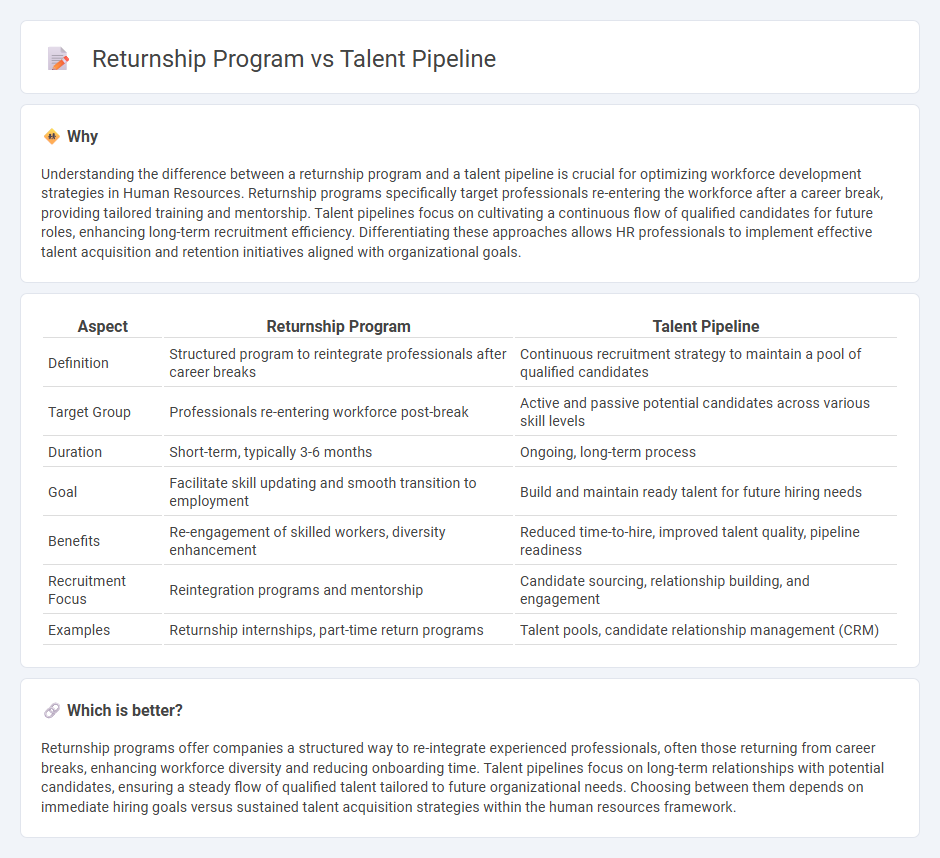
Returnship programs provide structured opportunities for professionals re-entering the workforce after a career break, focusing on skill refreshment and reintegration. Talent pipelines concentrate on ongoing recruitment and development strategies to ensure a steady flow of qualified candidates for future organizational needs. Explore how combining these approaches can enhance workforce diversity and retention.
Why it is important
Understanding the difference between a returnship program and a talent pipeline is crucial for optimizing workforce development strategies in Human Resources. Returnship programs specifically target professionals re-entering the workforce after a career break, providing tailored training and mentorship. Talent pipelines focus on cultivating a continuous flow of qualified candidates for future roles, enhancing long-term recruitment efficiency. Differentiating these approaches allows HR professionals to implement effective talent acquisition and retention initiatives aligned with organizational goals.
Comparison Table
| Aspect | Returnship Program | Talent Pipeline |
|---|---|---|
| Definition | Structured program to reintegrate professionals after career breaks | Continuous recruitment strategy to maintain a pool of qualified candidates |
| Target Group | Professionals re-entering workforce post-break | Active and passive potential candidates across various skill levels |
| Duration | Short-term, typically 3-6 months | Ongoing, long-term process |
| Goal | Facilitate skill updating and smooth transition to employment | Build and maintain ready talent for future hiring needs |
| Benefits | Re-engagement of skilled workers, diversity enhancement | Reduced time-to-hire, improved talent quality, pipeline readiness |
| Recruitment Focus | Reintegration programs and mentorship | Candidate sourcing, relationship building, and engagement |
| Examples | Returnship internships, part-time return programs | Talent pools, candidate relationship management (CRM) |
Which is better?
Returnship programs offer companies a structured way to re-integrate experienced professionals, often those returning from career breaks, enhancing workforce diversity and reducing onboarding time. Talent pipelines focus on long-term relationships with potential candidates, ensuring a steady flow of qualified talent tailored to future organizational needs. Choosing between them depends on immediate hiring goals versus sustained talent acquisition strategies within the human resources framework.
Connection
Returnship programs act as strategic initiatives within Human Resources to reintegrate skilled professionals, often after career breaks, into the workforce, directly feeding the talent pipeline with experienced candidates. These programs enhance talent acquisition by diversifying the pool of potential hires and accelerating workforce readiness. Integrating returnships strengthens long-term talent pipeline sustainability by fostering retention and career development.
Key Terms
**Talent Pipeline:**
A talent pipeline is a strategic, ongoing process aimed at identifying, attracting, and nurturing potential candidates to fill future job openings efficiently. It emphasizes building long-term relationships with skilled professionals through continuous engagement, talent development, and proactive recruitment efforts. Explore how developing a robust talent pipeline can ensure sustained workforce readiness and competitive advantage.
Recruitment
Talent pipelines streamline recruitment by continuously identifying and nurturing potential candidates, ensuring a steady flow of skilled talent tailored to organizational needs. Returnship programs specifically target professionals re-entering the workforce, offering structured opportunities to refresh skills and reintegrate into their career paths. Explore how these strategic recruitment approaches can enhance your workforce planning and talent acquisition outcomes.
Succession Planning
Talent pipelines proactively cultivate internal candidates for future leadership roles, ensuring smooth succession planning by continuously developing skills and competencies. Returnship programs specifically target experienced professionals re-entering the workforce, enriching the succession pool with diverse perspectives and proven expertise. Explore how integrating both strategies can optimize your succession planning efforts.
Source and External Links
How to Build a Strong Talent Pipeline for Future Leadership - A talent pipeline is the strategic process of preparing internal employees for future leadership roles to ensure a continuous flow of qualified leaders ready to fill key positions, which helps organizations minimize disruption from turnover and maintain growth.
How To Build a Robust Talent Pipeline? Your 101 Guide - Talent pipeline management involves proactively identifying, attracting, developing, and retaining a pool of qualified candidates to meet current and future organizational needs, integrating recruitment strategies, engagement, and succession planning for workforce continuity.
Talent Pipeline Management - Idaho Workforce Development - Talent Pipeline Management (TPM) is an employer-driven approach that connects businesses, educators, and job seekers to close skills gaps by mapping training paths and providing clear career pathways to prepare workers for essential roles in high quality careers.
 dowidth.com
dowidth.com